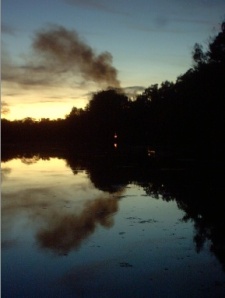 Philip Larkin’s poetry, on the surface traditional and apparently overt, is filled with tensions and contrasts: The poet both rejects the possibility of eternal life offered by Christianity and evokes our longing for that kind of certainty. His narrators are often detached, ironic observers of other people, yet Larkin’s poems focus on the common experiences of humanity. Larkin wrote most often, and masterfully, with the old tools of rhyme and meter—but his poems concentrate on contemporary experience and use conversational, natural diction spiked with more lyric phrasing. Some poems use swearwords, but his language is alliterative, assonant, and rhythmic. His poems are rooted in place and description yet often leap into metaphors that transcend the just here, the just now. His poems are frequently very funny, often deeply cynical, and always extremely intelligent. On a personal note, I’m very drawn to Larkin’s handling of time: how he evokes scenes in his contemporary world but also captures how time seems to slow, or leap forward, or circle back.
Philip Larkin’s poetry, on the surface traditional and apparently overt, is filled with tensions and contrasts: The poet both rejects the possibility of eternal life offered by Christianity and evokes our longing for that kind of certainty. His narrators are often detached, ironic observers of other people, yet Larkin’s poems focus on the common experiences of humanity. Larkin wrote most often, and masterfully, with the old tools of rhyme and meter—but his poems concentrate on contemporary experience and use conversational, natural diction spiked with more lyric phrasing. Some poems use swearwords, but his language is alliterative, assonant, and rhythmic. His poems are rooted in place and description yet often leap into metaphors that transcend the just here, the just now. His poems are frequently very funny, often deeply cynical, and always extremely intelligent. On a personal note, I’m very drawn to Larkin’s handling of time: how he evokes scenes in his contemporary world but also captures how time seems to slow, or leap forward, or circle back.
As we noticed in our Book Club for Poets discussion of some of Larkin’s shorter lyrics, it would be a mistake to confuse this poet’s clarity for simplicity. “The Trees” starts out by apparently striking the familiar chord of spring as a metaphor for rebirth: “The trees are coming into leaf / Like something almost being said.” But by the fourth line of that first quatrain, this isn’t a statement of simple, optimistic renewal: “Their greenness is a kind of grief.” It’s the exploration of the source of that grief that drives the rest of the poem.
As Ellen Bryant Voigt has noted in The Art of Syntax, while the first stanza is extremely regular in its iambic pattern, the second breaks the pattern:
Is it that they are born again
And we grow old? No, they die too.
(Voigt hears “No, they die too” as four stressed beats in a row. It’s certainly possible to read the line that way, though I think perhaps “die” is not stressed. Larkin doesn’t seem to stress it in a Poetry Archive recording.) Voigt notes that even though the rest of the poem reasserts the regular iambic pattern, “an unease has entered the poem at its center” (69). When Larkin returns to the image of the trees in “fullgrown” leaf, they only “seem” to be saying “Begin afresh, afresh, afresh.” The final word of the poem—“afresh”—is actually the source of our grief. The rebirth of the trees is an illusion—but even that illusion is beyond our human abilities. That sensation of renewal is powerful, however, and cheerfully asserted: grief and hope expressed to us simultaneously.
Part of our enjoyment in reading this poem comes from its music—its rhythms and sound echoes. Within that music, Larkin is capable of both colloquial speech and more traditionally lyric statement:
Their yearly trick of looking new
Is written down in rings of grain.
It’s the contrast of that casual “yearly trick,” I think, that makes the music of the next line and its metaphor deeply satisfying, with its repetition of r sounds and very regular iambic meter. At the same time, “yearly trick” balances out, grounds, the poetic impulse to compare the growth rings of trees to something “written.” In the wrong hands such a metaphor might seem like a clumsy, or precious, personification.
Voigt notes that in “Cut Grass,” another short lyric, it’s easy to misread the poem as making a distinction between the “Long, long” death of the mown grass and the survival of a series of fruitful summer images—chestnut flowers, hedges snowlike strewn, Lost lanes of Queen Anne’s lace, a high-builded cloud. But the prepositional phrases of the second sentences in the poem actually suggest that all the flowers and images of summer are not just living “in” June but actually dying “with” the grass:
Long, long the death
It dies in the white hours
Of young-leafed June
with chestnut flowers …
The trochees in this list of summer images—young leafed, lost lanes, high-builded—echo the opening double trochees of the very first line: Cut grass | lies frail. (See Voigt’s full discussion of the poem in The Art of Syntax, 73–77.) It’s the poem’s capacity to have two simultaneous meanings—one of them considerably darker than the other—that creates a sense of surprise in our reading of the poem, and it’s that surprise that makes the poem memorable.
Since our Book Club discussion of “The Whitsun Weddings”—a long, complex poem—I’ve had the chance to more fully explore the stanza structure of the poem. Joshua Weiner notes, “Larkin manages the easy naturalness of his voice so flawlessly that one hardly notices the poem’s rhyming stanza structure (ABABCDECDE), a kind of shortened sonnet (the quatrain is Shakespearean, the sestet Petrarchan).” Weiner points out that “Keats invented this stanza for his summer odes,” so Larkin both “evokes the summer season, its redolent promise and pastoral sweetness” and balances this sweetness with “grittier” images of “industrial froth” and “the stale smell of the cloth seats inside the train carriage.”
James Fenton also discusses this stanza form, including the effect of the shortened third line of each stanza of “The Whitsun Weddings” He compares Larkin’s formal pattern to that of Keats in Ode to a Nightingale:
My heart aches, and a drowsy numbness pains
My sense, as though of hemlock I had drunk,
Or emptied some dull opiate to the drains
One minute past, and Lethe-wards had sunk:
‘Tis not through envy of thy happy lot,
But being too happy in thine happiness —
That thou, light-wingèd Dryad of the trees,
In some melodious plot
Of beechen green, and shadows numberless,
Singest of summer in full-throated ease.
Here the short line (“In some melodious plot”) doesn’t appear until line 8 and creates what Fenton calls “an interesting variation.” Because that short line appears well into the established pattern of the poem, it strikes me as evoking the opposite of “delayed gratification”: an early, easy fulfillment of the rhyme pattern—an ease appropriate to the “happy lot” of the bird.
Fenton notes that “Larkin imitates [Keats’s] design in The Whitsun Weddings, but he puts his signature on the form by varying the placing of the short line.” The resulting effect, Fenton says, is “a carefully prepared but relaxed, prosy effect: the urban details, lovingly marshalled, prepare us for the beauty of the rural evocation of the last two lines [of the first stanza].” I think the first short line, which comes so early in the poem, certainly seems more like an abrupt statement—with that proselike quality Fenton talks about—than an “interesting variation.” That is, there hasn’t been enough pattern established yet in the first stanza for that third line to seem like variation. Fenton observes that the short line in Larkin’s poem may have appeared early in the stanza by “chance.” “But,” he continues, “once it has happened in that way, in a regular stanzaic poem, the pattern must be repeated, but repeated in a way that is not repetitive. If you look at the short lines in The Whitsun Weddings from a technical point of view, you will find that each is handled in a slightly different way: enjambed with line before or after it, made to stand alone, broken with a comma, and so forth. Each variation seems utterly natural, but each has been prepared for.”
What I love in this poem is the way it shifts, subtly, inexorably, in place and time and attitude. The oddly quantitative opening—“Not till about / One-twenty on the sunlit Saturday / Did my three-quarters-empty train pull out”—will give way to descriptions of the landscape; then depictions, perhaps condescending, of working-class wedding parties; then multiple points of view, as the narrator imagines how the different people at the weddings—children, fathers, mothers, young women—feel about the ceremony that’s just taken place; to descriptions of the increasingly urban landscape; to the narrator’s recognition of at least the potential of marriage, in the phrase “all the power / That being changed can give”; and finally to that closing metaphor of “an arrow-shower / Sent out of sight, somewhere becoming rain.” Time presses only onward, as the image of the “short-shadowed cattle” early in the trip is replaced by “Long shadows over major roads” later in the afternoon. At the same time, the pastoral and urban change in proportion to one another but always overlap in the landscape, as the pollution tainting the countryside in “Canals with floatings of industrial froth” makes way for a vision of London as a kind of cultivated farmland: “I thought of London spread out in the sun, / Its postal districts packed like squares of wheat.”
In the penultimate stanza, the narrator has a vision that the married couples themselves do not: the past, present, future are brought together in a very moving, even tender way: “and none / Thought of the others they would never meet / Or how their live would all contain this hour.” In the future, the individual couples won’t recognize this shared journey as part of their past, which is now the present moment of the poem. Only the narrator sees past, future, present coalesce like this. His recognition of this moment—this journey of “some fifty minutes”—is underscored by his awareness that the moment is on the brink of passing, with the train’s arrival in London: “walls of blackened moss / Came close, and it was nearly done, this frail / Travelling coincidence.” In an interview in the Paris Review, Larkin spoke about his desire as a poet to capture experience: “You’ve seen this sight, felt this feeling, had this vision, and have got to find a combination of words that will preserve it by setting it off in other people. The duty is to the original experience.” His narrator in “The Whitsun Weddings” seems to feel the same urgency to recognize, and so capture, the fleeting moment.
Running through all of this movement is the music of Larkin’s poetry. Note the alliteration and assonance of these line:
All afternoon, through the tall heat that slept
For miles inland,
A slow and stopping curve southwards we kept.
Wide farms went by, short-shadowed cattle, and
Canals with floatings of industrial froth;
A hothouse flashed uniquely: hedges dipped
And rose …
In addition to the end rhymes, these lines contain the internal rhymes All/tall in the first two lines; the long o echoes of slow, shadowed, floatings, rose; the long i sounds of miles and wide, and the short i’s of inland, industrial, dipped. There’s also the alliteration of slow, stopping, southwards; short-shadowed; floatings, froth; hothouse, hedges. The rhythm includes variations of iambic pentameter, with five beats in nearly every line. There is an example of poetic inversion of the syntax—“A slow and stopping curve southwards we kept”—but the language of the description is so clear and the phrasing of the first stanza was so matter-of-fact that this inversion doesn’t strike the ear, it seems to me, as “too poetic.”
Another poem that we discussed in detail was “The Explosion.” This poem isn’t rhymed, but it follows a metrical pattern, trochaic tetrameter, the same meter as Longfellow’s The Song of Hiawatha. Stephen Dobyns notes, in Best Words, Best Order, that this use of meter expresses a difference in class in British poetry, iambic pentameter being representative of elevated, upper-class language, and trochaic patterns of lower, “uneducated” classes (117). The poem is also a wonderful example of how narrative and lyric writing can be combined in the same poem—and how Larkin creates a sense of surprise in his poetry. As the Book Club discussed, the explosion itself is not a surprise: the title of the poem sets us up to expect it. What is surprising, as Dobyns notes, is that “Larkin greatly diminishes the actual explosion” (47):
At noon, there came a tremor; cows
Stopped chewing for a second; sun,
Scarfed as in a heat-haze, dimmed.
The explosion is experienced for readers as it would have been for people at the surface, not down in the mine with the workers. As I noted in our Book Club discussion, the telegraphic phrasing and pauses of this stanza echo the description of the probably young miner earlier in the poem:
One chased after rabbits; lost them;
Came back with a nest of lark’s eggs;
Showed them; lodged them in the grasses.
After the explosion, the poem suddenly shifts into the language of the church, quoted in italics: The dead go on before us. The opening of the next stanza, “Plain as the lettering in the chapels / It was said,” is intriguing. What is “plain as the lettering in the chapels”? And when does it become plain? Has the poem actually jumped to the event of the men’s funeral service? Or is the mind anticipating the funeral, the language of the church being imagined at the very moment of the explosion—that kind of tremor being subtly but unmistakably, to a miner’s wife, a fatal sign? That is, do the women’s thoughts jump from the first evidence of an explosion immediately to the immortality of the soul?
With the stanza that begins The dead go on before us, the poem doesn’t follow a strictly narrative approach. In lyric fashion, it jumps by association from the memorial service to the imaginations of the surviving widows—who envision how their husbands seem in death “Larger than in life they managed— / Gold as on a coin, or walking / Somehow from the sun towards them.”
As Dobyns says, “The shifts in time, language, and levels of reality all create surprises, that is, they are unexpected. … These surprises leave us uncertain as to what lies ahead and set us up for the main surprise, which is the reappearance of the eggs” (49). That final image of “the eggs unbroken” has been interpreted by critics as an allusion to the immortality of the soul, and eggs in Christianity certainly are associated with resurrection. But I think they also allude to the fragility of life, how easily lives can be broken—and to the irony that the natural workings of the world continue as they always have, despite the death of any individual human, no matter how beloved.
More than one of my teachers noted over the years that some writers are known for innovation, like Joyce and Eliot—while others are known for taking traditional forms and fulfilling their potential in a masterful way. John Milton falls into this camp, as does Robert Frost and, I think, Elizabeth Bishop. And certainly Philip Larkin does. Even for those of us who may not choose to write in metrical forms, Larkin has a lot to teach us about pattern and variation, layers of possible meaning—even paradoxical meanings—tension, texture, music, movement.
When we turn to the poetry of Bishop for the April 11, 2012, meeting of the Book Club for Poets, it will be interesting to compare her work to Larkin’s. We’ll see in a poem like “The Moose,” for example, a complex journey similar to that of “The Whitsun Weddings” as well a combination of lyric and narrative approaches similar to that of “The Explosion.”
Works Cited
Dobyns, Stephen. Best Words, Best Order (St. Martin’s Griffin, 1996; paperback 1997).
Fenton, James. “Writing to a Tall Order: James Fenton Looks at the Most Complicated Forms of Rhyme.” Guardian, September 20, 2002, http://www.guardian.co.uk/books/2002/sep/21/featuresreviews.guardianreview24. (This article is an “edited extract” from Fenton’s An Introduction to English Poetry, the first American edition of which was published by Farrar Straus Giroux in 2002.)
Phillips, Robert. “Philip Larkin: The Art of Poetry No. 30” (interview). Paris Review 84 (summer 1982), http://www.theparisreview.org/interviews/3153/the-art-of-poetry-no-30-philip-larkin. (Larkin rarely gave interviews.)
Voigt, Ellen Bryant. “On the Grid.” In The Art of Syntax: Rhythm of Thought, Rhythm of Song (Graywolf, 2009), 65–77.
Weiner, Joshua. “Philip Larkin: ‘The Whitsun Weddings’: Philip Larkin Swings” [in “Poem Guide” section]. The Poetry Foundation, 2011, http://www.poetryfoundation.org/learning/poem/178047.
© 2012 Martha Carlson-Bradley
 In addition to its humanity — its giving voice to people that history and art have often overlooked — one of the great pleasures of Eavan Boland’s poetry is the way it layers time and moves through time. At our last meeting, the Book Club for Poets focused on poems from Against Love Poetry, several of which show Boland’s ability to merge past and present, historical and personal, the captured moment and the fleetingness of time.
In addition to its humanity — its giving voice to people that history and art have often overlooked — one of the great pleasures of Eavan Boland’s poetry is the way it layers time and moves through time. At our last meeting, the Book Club for Poets focused on poems from Against Love Poetry, several of which show Boland’s ability to merge past and present, historical and personal, the captured moment and the fleetingness of time.








